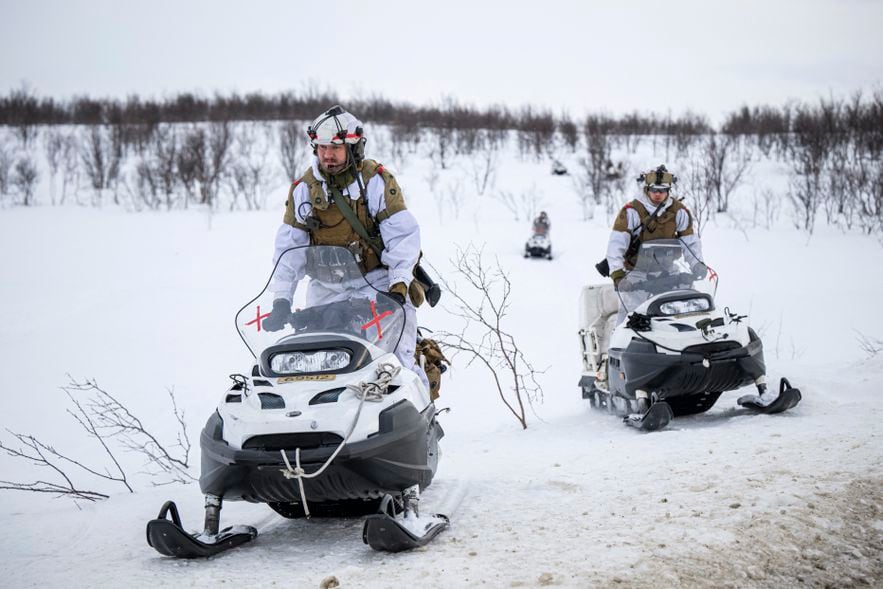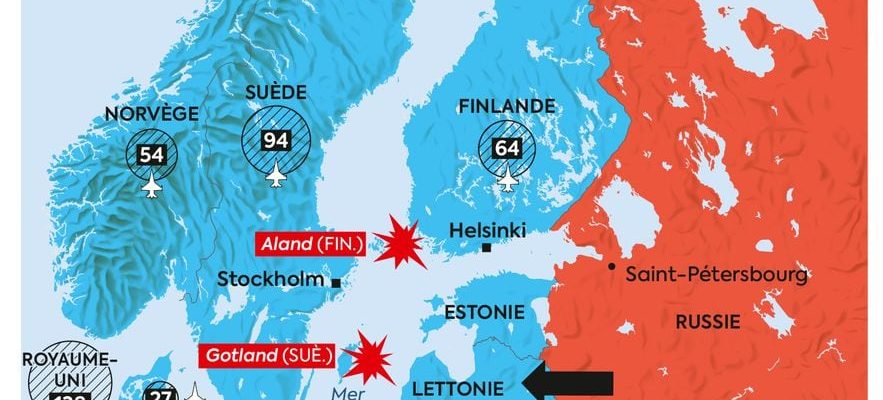When the thermometer reads -15°C, Swedish corporal Juhani Ahokas judges that it is not cold. “Frankly, I’m almost a little hot,” smiles, on this freezing but sunny March day, the armored vehicle driver. Around him, the passengers of his CV90 combat vehicle, strapped into white outfits, agree, as they are used to temperatures that drop to -30°C. After a brief improvised exchange, the crew of six soldiers set off again to “combat” across the wild landscape of Finnmark, a succession of snow-covered valleys and frozen rivers over which helicopters and fighter planes fly. In the distance, we hear artillery fire…
Welcome to northern Europe where, in January, Nordic Response 24 began, a vast military training exercise that is part of an even larger exercise, Steadfast Defender – the most ambitious organized by NATO since the end of the cold War. In total, 90,000 soldiers from 32 allied countries will be deployed until June across the Old Continent, as far as Romania. The first phase of this war game takes place astride the triple border of Norway, Finland and Sweden. Nordic Response 24 mobilizes “only” 20,000 people from 13 countries, more than 100 warships, five submarines, tanks and armored vehicles, helicopters, fighter planes. Without forgetting snowmobiles: “We use them to infiltrate behind enemy lines,” slips French Colonel Marc Antoine, of the 7th Alpine Hunter Battalion, who is participating in NATO maneuvers.
Map produced with the help of Tomas Ries, from the Swedish Defense Institute –
© / Legends Cartography
The Nordic Response 24 scenario? A great foreign power from the East launches an offensive in Finnmark (Norway). In this context, the mission of the blue team (the Allies) consists of repelling the red team (the enemy) by all means to allow the arrival of maritime reinforcements: by sea via the Norwegian port of Alta, in the north; by land, from Sweden, to the south; and by air. This exercise takes place in the context of the war in Ukraine and the enlargement of NATO to Finland and Sweden, which became the 32nd country in the Alliance on March 7.
“We know that the Russians are watching us; maybe they even have spies on the ground but that’s good,” says General Terje Bruøygard, a Norwegian Malabar. Understandably: the Kremlin will thus see what Nordic Response 24 has in store for it in the event of aggression. “Vladimir Putin has clearly said that he does not like freedom, democracy and human rights. But these are all the values that we defend. The clash of civilizations is where it is happening!”, thunders this “General Patton of the Arctic”.
“You are dead!”
For total realism, the soldiers, who fight with blank bullets, are equipped with laser sights and connected electronic vests. When a laser shot from the opposing camp hits a soldier, the vest sends a voice message: “You are dead!” (you are dead) or “wound!” (hurt). Then he was sidelined from the game for a while. If the “projectile” (laser) narrowly misses him, the fighter hears his vest hiss: “Phew…” And if a (false) chemical attack occurs, he has ten seconds to put on his gas mask; otherwise he “dies” on the battlefield. As in real war, some civilians replace the soldiers: “The local people know how to ‘read’ the snow, the wind and the geography like no one else; it is very useful in the weather conditions which put men and equipment to great strain ordeal”, remarks British Lieutenant Hoyle, stationed in the port town of Alta where the Royal Navy is increasing the number of landings.
Swedish soldier Juhani Ahokas, driver of a CV-90 armored personnel carrier, in Finnmark (Norway) during the Nordic Response 24 exercise, March 12, 2024
© / Renaud Toffier/ L’Express
Further south, in a field HQ installed in containers, senior officers follow the progress of land operations on a big screen, thanks to the connected system. “This allows us to learn lessons in real time,” explains Norwegian Colonel Ken-Tore Eriksen. “We have calculated that without this electronic system made in Sweden [NDLR : par la société Saab]we would have to repeat the military operations more than 15 times to reach the same knowledge and conclusions.”
“I don’t see who could beat them.”
During the Cold War, NATO already organized military training in these latitudes. They have continued since then, at an annual rate. But they have never taken place so close to the Russian border, only 200 kilometers away (compared to 300 previously). The question is: why organize major maneuvers where there are more reindeer than humans? “Many people don’t know this, but in the event of a general conflict with Russia, the Finnmark region in Norway and the Kola peninsula in Russia would be one of the first points of conflict,” he explains. Stockholm, Swedish-Finnish expert Tomas Ries, of the renowned Swedish Defense University. “Russia in fact stations most of its submarines in bases dug into the rock of the Kola peninsula. In the event of war, their first mission would be to go out to sea, go around the north cape then go back down towards the Atlantic in order to establish a maritime blockade between America and Europe.” More importantly: among its fleet of submersibles, Moscow has 11 capable of launching long-range nuclear missiles. Eight of them have the Kola region as their home base. Which makes the peninsula a considerable strategic issue.

The Norwegian National Guard of the 17th “District Company Ida og Lyra”, on March 8, 2024 in Alta, participates in the NATO exercise Nordic Response 24.
© / Jonathan NACKSTRAND / AFP
During an open-air press conference, a group of European journalists, including L’Express, listen to the imposing Norwegian general Bruøygard: “If Putin feels threatened or if he decides to be aggressive, Finnmark is typically the region where Russia will want to advance its anti-aircraft defenses to protect its rear,” he adds. For now, this scenario seems unimaginable – especially since Russian troops usually assigned to the region bordering Finland are mobilized against kyiv. But in the event that Russia wins in Ukraine and Donald Trump, once elected, leaves the Atlantic Alliance, Putin, who is already working to strengthen his army, would find himself emboldened…
In Stockholm, Tomas Ries lists the other scenarios under study: “In addition to military action against Latvia [NDLR : où 1 habitant sur 4 est russophone] or another Baltic country, the Russian army could launch a ‘special operation’ against one of the vulnerable Baltic islands: the archipelago of Aland (Finland), Gotland (Sweden) or Bornholm (Denmark). However, once conquered by the enemy, an island is difficult to recapture, especially if he installs anti-aircraft batteries there.” What’s more, in accordance with its doctrine, Russia would, without doubt, play the psychological war card , that is to say the nuclear threat. Without the guarantee of American aid, Europeans would be paralyzed with fear.
In the meantime, in mid-March, American F-35s landed for the first time on Swedish soil, near Boden, which is an important garrison. A way to celebrate Sweden’s entry into NATO. That day, Nordic Response 24 looked like an air show, with incessant landings and takeoffs of F-35s and JAS 39 Gripen. “Taken together, the air forces of the Baltic rim countries represent a formidable power [NDLR : près de 500 avions de chasse si on y ajoute les appareils anglais et hollandais], notes American General Scott F. Benedict, of the US Marines. I don’t see who could beat them,” he adds, in an aircraft hangar, drinking coffee. This is undoubtedly true today. But tomorrow, what if the Americans abandon NATO?
.
